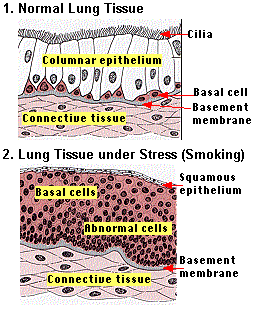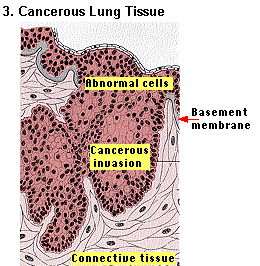|
Consider lung cancer. The pictures on the left (click
for source) represent the growth of lung cancer in a chronic smoker.
The basal cells in normal
lung
tissue
(Graphic 1 on left)
represent the stem cells for the columnar epithelium, which is the interior
lining
of the
lungs. This is the tissue most exposed to smoke in a cigarette.
Due to cellular stress caused by the toxins in cigarette
smoke, the basal cells naturally divide to provide a thicker layer of
cells against the toxins (Graphic 2 - after approx. 10 years smoking).
The top layer of cells flatten out and form a more protective barrier
also.
It
is almost
like
the lining
of
the lungs,
is becoming more like your skin to protect you from the toxins. The problem
is that many of these basal cells are mutants with a very abnormal nucleus.
In time, some mutations happen that cause the cells
to produce protease proteins to melt through the basement membrane of
the lung tissue (Graphic 3 - after approx. 20 years smoking) and start
to invade other tissue. Most of these
cells
secrete
a mucous
similar to the basement membrane to protect the group from the immune
system. Others will occassionally produce the protease that allow them
to break from the group through the mucous and invade additional tissue.
Reovirus
represents a natural enemy of growing cancers. The lead cancerous
cells, secret
proteases
on their
growing
edges that
melt cell junctions and membranes in front of them. These same proteases
melt the outer
protective
protein coat of the reovirus making it more likely to infect the cell.
The cancer cells that produce the mucous also have a
problem with Reovirus. An uncoated
reovirus particle exposes a sigma1 attachment fiber that can drill through
this mucous to reach and infect the cell.
Once inside the cancer cell, the Reovirus may invoke
cell death and signalling of the immune system through apoptosis, or,
it may continue to divide and destroy the cell itself. The response in
the cell depends alot on the type of cell mutations it contains. It is
thought that a mutation in the Ras cell pathway is enough to signal apoptosis
and the immune cells. Further, addtional mutations though Ras/RalGEF/p38
cell pathway determine if Reovirus can replicate (click
for source). The
normal
cellular
defense
against
reovirus
(activated
PKR) appears to be controlled by this pathway.
Finally, the dead or dying
cancer cells are likely to attract the immune system. Should these
cells show cell surface
features or other things that are abnormal, the immune system will
be alerted to watch out for these cell types. |

